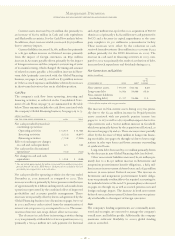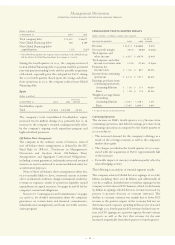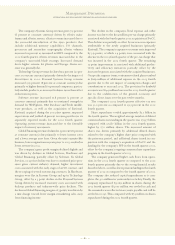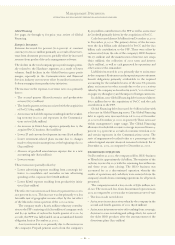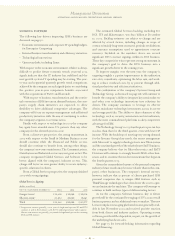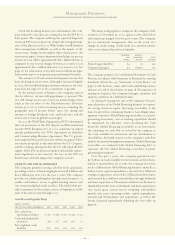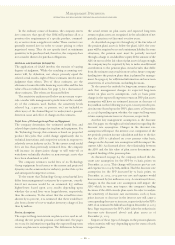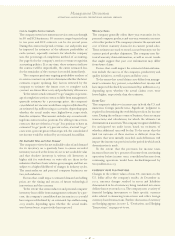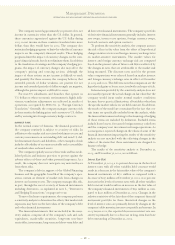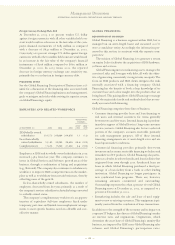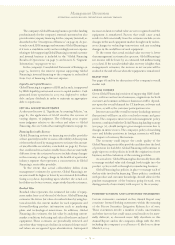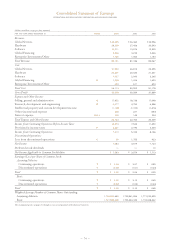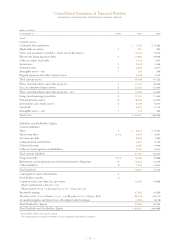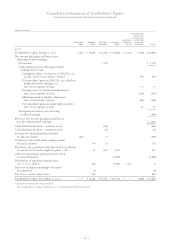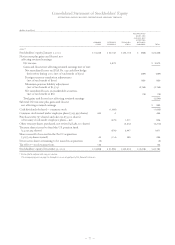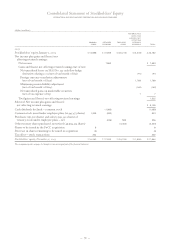IBM 2003 Annual Report Download - page 70
Download and view the complete annual report
Please find page 70 of the 2003 IBM annual report below. You can navigate through the pages in the report by either clicking on the pages listed below, or by using the keyword search tool below to find specific information within the annual report.
The company earned approximately 56 percent of its net
income in currencies other than the U.S. dollar. In general,
these currencies appreciated against the U. S. dollar during
2003 so net income in these countries translated into more
dollars than they would have in 2002. The company also
maintains hedging programs to limit the volatility of currency
impacts on the company’s financial results. These hedging
programs limit the impact of currency changes on the com-
pany’s financial results but do not eliminate them. In addition
to the translation of earnings and the company’s hedging pro-
grams, the impact of currency changes also may affect the
company’s pricing and sourcing actions, although the
impact of these actions on net income is difficult to track
and quantify. For these reasons, the company believes that
extended periods of dollar weakness are positive for net
income and extended periods of dollar strength are negative,
although the precise impact is difficult to assess.
For non-U.S. subsidiaries and branches that operate in
U.S. dollars or whose economic environment is highly infla-
tionary, translation adjustments are reflected in results of
operations, as required by SFAS No. 52, “Foreign Currency
Translation.” Generally, the company manages currency risk
in these entities by linking prices and contracts to U.S. dollars
and by entering into foreign currency hedge contracts.
MARKET RISK
In the normal course of business, the financial position of
the company routinely is subject to a variety of risks. In
addition to the market risk associated with interest rate and
currency movements on outstanding debt and non-U. S. dol-
lar denominated assets and liabilities, other examples of risk
include collectibility of accounts receivable and recoverability
of residual values on leased assets.
The company regularly assesses these risks and has estab-
lished policies and business practices to protect against the
adverse effects of these and other potential exposures. As a
result, the company does not anticipate any material losses
from these risks.
The company’s debt in support of the Global Financing
business and the geographic breadth of the company’s oper-
ations contain an element of market risk from changes in
interest and currency rates. The company manages this risk,
in part, through the use of a variety of financial instruments
including derivatives, as explained in note L, “Derivatives
and Hedging Transactions,” on pages 96 to 99.
To meet disclosure requirements, the company performs
a sensitivity analysis to determine the effects that market risk
exposures may have on the fair values of the company’s debt
and other financial instruments.
The financial instruments that are included in the sensi-
tivity analysis comprise all of the company’s cash and cash
equivalents, marketable securities, long-term non-lease
receivables, investments, long-term and short-term debt and
all derivative financial instruments. The company’s portfolio
of derivative financial instruments generally includes interest
rate swaps, interest rate options, foreign currency swaps,
forward contracts and option contracts.
To perform the sensitivity analysis, the company assesses
the risk of loss in fair value from the effect of hypothetical
changes in interest rates and foreign currency exchange rates
on market-sensitive instruments. The market values for
interest and foreign currency exchange risk are computed
based on the present value of future cash flows as affected by
the changes in rates that are attributable to the market risk
being measured. The discount rates used for the present
value computations were selected based on market interest
and foreign currency exchange rates in effect at December
31, 2003 and 2002. The differences in this comparison are the
hypothetical gains or losses associated with each type of risk.
Information provided by the sensitivity analysis does not
necessarily represent the actual changes in fair value that the
company would incur under normal market conditions
because, due to practical limitations, all variables other than
the specific market risk factor are held constant. In addition,
the results of the model are constrained by the fact that cer-
tain items are specifically excluded from the analysis, while
the financial instruments relating to the financing or hedging
of those items are included by definition. Excluded items
include leased assets, forecasted foreign currency cash flows
and the company’s net investment in foreign operations. As
a consequence, reported changes in the values of some of the
financial instruments impacting the results of the sensitivity
analysis are not matched with the offsetting changes in the
values of the items that those instruments are designed to
finance or hedge.
The results of the sensitivity analysis at December 31,
2003, and December 31, 2002, are as follows:
Interest Rate Risk
At December 31, 2003, a 10 percent decrease in the levels of
interest rates with all other variables held constant would
result in a decrease in the fair market value of the company’s
financial instruments of $170 million as compared with a
decrease of $237 million at December 31, 2002. A 10 percent
increase in the levels of interest rates with all other variables
held constant would result in an increase in the fair value of
the company’s financial instruments of $152 million as com-
pared to $210 million at December 31, 2002. Changes in the
relative sensitivity of the fair value of the company’s financial
instrument portfolio for these theoretical changes in the
level of interest rates are primarily driven by changes in the
company’s debt maturity, interest rate profile and amount. In
2003 versus 2002, the reported decrease in interest rate sen-
sitivity is primarily due to a decrease in long-term fixed rate
debt outstanding at December 31, 2003.
Management Discussion
INTERNATIONAL BUSINESS MACHINES CORPORATION AND SUBSIDIARY COMPANIES
68


